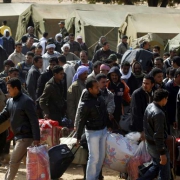Can Mobiles Increase Farmers’ Profits? Evidence from Malawi
USAID’s Mission in Malawi has evidence that mobile phones can and do have an impact on local farmers’ profits, according to Vince Langdon-Morris, an agricultural specialist with the Agency. Langdon-Morris explained that USAID Malawi’s is helping small-medium agricultural enterprises monitor and sell their products using an innovative mobile phone platform, similar to Esoko from Ghana.
In very simple terms, the commodity chain of agricultural production in Malawi is being modified in the following way by this project:
- Farmers harvest grains and communicate with buyers via phone.
- Small-medium business owners purchase farmers’ grains and monitor their product inventory and sales at their aggregation centers by phone.
- The owners sell the grains in bulk to larger agri-businesses, checking market prices on their phones to ensure a quality sales price.
The phone helps the farmer to know where he should sell his grains at the best price and when the owner is willing to buy. The phone helps the small-medium enterprise owner because he can monitor the collections at the 20-30 aggregation centers that he usually operates, allowing him to sell in bulk at the right times and limiting his travel costs, among other benefits.
Mobile phones are tools to promote economic growth and other forms of development. Certainly, mobile phones are not the cure to all problems, but they can facilitate programs that do directly reduce poverty, such as this agricultural project by USAID Malawi. Other missions would do well to mimic their efforts and incorporate technology into their current projects in order to enhance effectiveness.
Given the success of M-PESA and other revolutionary applications like MXit and Ushahidi, mobiles4development (hastag #m4d on twitter) is gaining political clout within many development spheres, seemingly replacing microfinance as the solution to end poverty. Champions of m4d do not fail to mention World Bank studies that describe the connections between mobile phone usage and economic growth, improved healthcare, better agriculture, etc.
Unfortunately, such claims are overstated, as mobile phones cannot solve poverty. They can, however, be tools for improving development projects, as seen in Malawi. The test for USAID missions, then, will be to utilize mobiles phones as tools for development projects, but maintain a critical eye about their effectiveness.







































